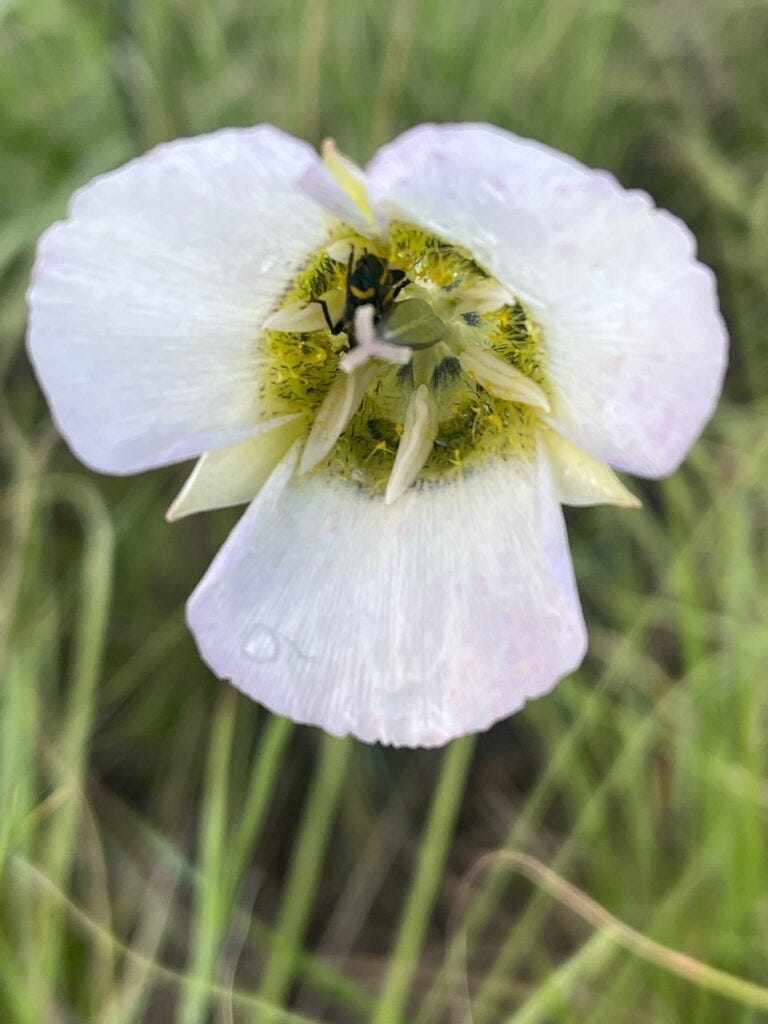Mariposa Lillies
I was going to make my next post about the Ponderosa Pine Tree, but the Mariposa Lillies are thick in this area right now and they won’t be around much as of next week and on, so let’s talk about them while they are showing off. The Ponderosas will be here still.
Much that I read of the Mariposa or ‘Sego’ Lilly (Calochortus gunnisoni) is that they bloom from late spring to early summer. Not here at 8700 feet. Here, they begin to appear with the July monsoons and they will be gone all too soon. Walking the roads and trails, (I find them mostly in our meadow close to the marsh), you will notice a bright white, or faint pink, or light blue flower, just a couple of inches wide. Look inside and look close, there is a complex, kaleidoscope-like circle of yellow, orange, maroon, pink, green, or black, fine hairs. It’s worth the pause to take a look inside each.
‘Mariposa’ is a Spanish word for butterfly. This flower, of the genus Calochortus, meaning, beautiful grass, caught the eye of early explorers and botanists such as Meriwether Lewis, Thomas Nutall, Nathaniel Wyeth, and Frederick Creutzfeldt, but this flower had been well known to Native Americans much earlier. ‘Sego’ is a Shoshone word, meaning ‘edible bulb’, at times a delicacy eaten raw or boiled, other times dried and ground into flour for breads. When white, Mormon settlers to Utah found themselves facing starvation after failed crops, the Native Americans showed them how to find the Sego bulbs. The bulbs became such an important factor in their survival, the Sego Lilly was made the state flower of Utah.
If you’d like to try a Sego Lilly bulb, they are 4-6 inches deep and only about the size of a marble. They are said to taste like a nutty potato. Evidence of Sego Lilly being a part of the human diet dates back to pre-historic forager pit ovens found throughout the Rocky Mountain West, dating 4-5 thousand years ago. While not highly nutritious for the effort to obtain enough to consume, they did provide some carbohydrates needed for survival, as the Utah settlers appreciated.
If you are taking a walk out west in early to mid-summer, be sure to stop and enjoy the Mariposa while they bloom.
I will say this with any flower I discuss here - Please do not pick the flowers! Most are protected by Colorado state laws and once removed, they will not go to seed and create more flowers. Additionally, some flowers are not to be touched as they are toxic. Please leave all flowers where you found them for the next person to enjoy.
Sources:
https://www.swcoloradowildflowers.com/White%20Enlarged%20Photo%20Pages/calochortus.htm
https://coloradowildflower.com/wildflower/mariposa-lily-flower/
https://www.nps.gov/romo/mariposa_lily.htm
https://www.americansouthwest.net/plants/wildflowers/calochortus-gunnisonii.html
https://www.colorado.edu/asmagazine/2019/04/16/western-sego-lilies-reach-mountain-meadows-hot-deserts
https://www.motherearthnews.com/sustainable-living/nature-and-environment/sego-lily-and-the-death-camass-zmaz82jazgoe/
https://www.researchgate.net/publication/248579202_Sego_Lilies_and_Prehistoric_Foragers_Return_Rates_Pit_Ovens_and_Carbohydrates









